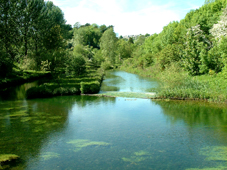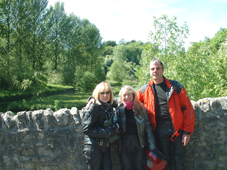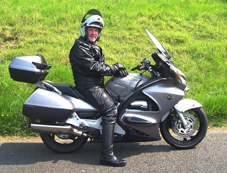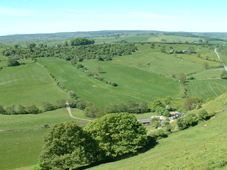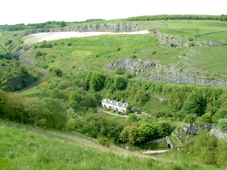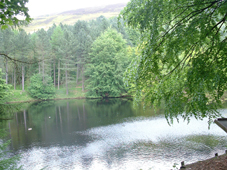 June
2006 Club Members visit The Peak District.
June
2006 Club Members visit The Peak District.
The trip up to the Peaks was planned to avoid Motorways,
which, apart from a little of the M40 was A and B roads. The distance to Buxton
(where we stayed www.roseleighhotel.co.uk)
is about 220 miles, we covered 830 miles in total.
Well worth looking at the following website if you plan to visit the Peaks.
Quote from www.visitpeakdistrict.com
“Get
away to it all... Right in the heart of England the Peak District includes
the
first National Park in Britain.
You will also find Chatsworth and Alton Towers, the starting point of the
Pennine Way long distance footpath and home to such nationally known products
as Buxton Mineral Water, Hartington Stilton and the delicious Bakewell Pudding.
Great places to visit, magnificent scenery and a host of things to do whilst
staying in your favourite style of accommodation, the Peak District has something
to offer everyone”.
The
trip was a Wednesday to Sunday stay in the beautiful Derbyshire Peak District
which offers visitors a very diverse range of countryside.
Not noted for its lakes, the Peak District has an abundance of water in the
form of reservoirs dams and rivers running throughout the area.

Ladybower
and the Derwent Dams - the Upper Valley of the Derwent is a deep valley surrounded
by gritstone edges and dominated by three great reservoirs, constructed by
the Derwent Valley Water Board primarily to provide water for Sheffield.
The upper two dams, Howden and Derwent, were constructed between 1901 and
1916 and they were such a large undertaking that a village called Birchinlee
was constructed in the upper valley to house the workers and a narrow-gauge
railway was built between Howden Dam and the Midland Railway at Bamford. Traces
of both these may still be seen. The dams were opened by King George V in
1916. Another claim to fame for the Derwent reservoirs is their association
with the ‘Dambuster’ squadron of the RAF, for they used the Derwent
to practise for their famous raid on the Ruhr dams. Since then this event
has been regularly commemorated in the Derwent valley with fly-pasts of old
bombers and aerial displays.www.cressbrook.co.uk/hopev/ladybwr.htm
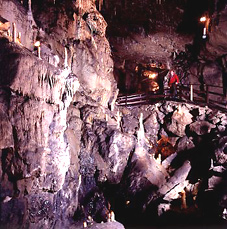 Day one
of the visit started wet, so we visited Poole Cavern. Quote from the webside
“Poole’s Cavern is a 2 million year old, natural limestone cave
situated in the beautiful woodland of Buxton Country Park in Derbyshire and
has been visited for 5,000 years since Neolithic tribes first used it’s
chambers as shelter. The cave has been known as ‘The First Wonder of
the Peak’ since the 1600s and recently celebrated its 150th anniversary
as an official showcave and tourist attraction. Modern visitors enter the
cavern in comfort through easilly accessible, illuminated chambers, with guided
tours leaving every 20 minutes from the visitor centre”. www.poolescavern.co.uk
Day one
of the visit started wet, so we visited Poole Cavern. Quote from the webside
“Poole’s Cavern is a 2 million year old, natural limestone cave
situated in the beautiful woodland of Buxton Country Park in Derbyshire and
has been visited for 5,000 years since Neolithic tribes first used it’s
chambers as shelter. The cave has been known as ‘The First Wonder of
the Peak’ since the 1600s and recently celebrated its 150th anniversary
as an official showcave and tourist attraction. Modern visitors enter the
cavern in comfort through easilly accessible, illuminated chambers, with guided
tours leaving every 20 minutes from the visitor centre”. www.poolescavern.co.uk
There are a number of Caverns in the Peak District mainly located in and around
Castleton www.cressbrook.co.uk/hopev/castletn.htm
The Castleton Caverns comprise of The Blue John Cavern, Treak Cliff Cavern,
Speedwell Cavern (all clustered around the Winnats pass) and the great Peak
Cavern, just outside Castleton itself.
The Snake Pass is probably most frequently heard of on weather and traffic
reports as it is usually one of the first trans-Pennine routes to be blocked
by snow and ice. However there is more to this picturesque valley than meets
the eye, for instance, how did it get its name? First impressions of the road
winding through the valley like a snake would suggest the name came from this
but the link with the road can be found elsewhere. The origins of the name
can be found in the early part of the 19th century when construction of the
Turnpike road began. A Turnpike Trust was set up to manage the toll road and
the then Duke of Devonshire was appointed Chairman. Tolls were collected at
the Snake Inn, then a coaching inn, which derived its name from the Duke of
Devonshire family coat of arms the ‘Snake and Staff’. Hill farming
has shaped the valley over the centuries. The field patterns and walls have
changed little since the 16th century. Stone sheep pens are a distinctive
feature in the landscape although some now are only ruins, others have been
carefully rebuilt.
This is just a little about the area, always
plan any visit before you go, which means the visit includes as much as possible,
we had a fabulous time during our visit, and are planning to return as soon
as we are able.
 Days 2 and 3. The
Peaks have some of the best roads we have ever come across, much of our sightseeing
however was spent almost off road, as you know from club runs we always plan
routes as far away from the main roads as possible. One such track involved
the opening and closing of gates, passing farms and cottages which have not
changed for 100’s of years. Another interesting feature we encountered
was a Ford, (some 25 meters wide, the base of which was 12” blocks) which
we took a chance on, we managed to slip and slide across without mishap (it
has been deleted from our routes for future visits).
Days 2 and 3. The
Peaks have some of the best roads we have ever come across, much of our sightseeing
however was spent almost off road, as you know from club runs we always plan
routes as far away from the main roads as possible. One such track involved
the opening and closing of gates, passing farms and cottages which have not
changed for 100’s of years. Another interesting feature we encountered
was a Ford, (some 25 meters wide, the base of which was 12” blocks) which
we took a chance on, we managed to slip and slide across without mishap (it
has been deleted from our routes for future visits).
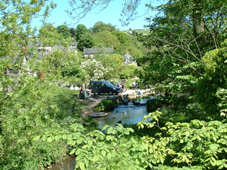
Another priceless encounter was a tiny place called Milldale which has a wonderful
tranquil river running under a historic stone footbridge, the cafe is a spilt
door in a private house, this area is near Ashbourne.
We also visited Holmfirth (Last of the Summer Wine country), although the
town was a little disappointing, the ride to get there was over one of the
highest most scenic roads in the Peaks with 360 degree views. From 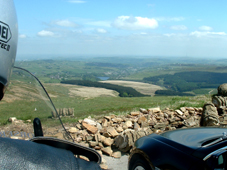 Holmfirth
we were told to take the A635 towards Oldham which is a well used biker road,
well, again the 360 degree views were amazing.
Holmfirth
we were told to take the A635 towards Oldham which is a well used biker road,
well, again the 360 degree views were amazing.
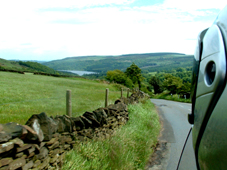 The
ride into the area on the day we arrived was along the A515 which was a fabulous
introduction to what the Peak District had in store for our visit. Sadly Sunday
arrived all too quickly, but we had a bonus on our way home.
The
ride into the area on the day we arrived was along the A515 which was a fabulous
introduction to what the Peak District had in store for our visit. Sadly Sunday
arrived all too quickly, but we had a bonus on our way home.
We
left the Peaks on the A53 which linked to the A523. these roads cover an elevated
area of the southern part of The Peaks, it was like riding at the height of
a low flying aircraft, the views for about 25 miles to all sides were stunning,
the road was about 20 miles long. Angie took 200 photos on this trip, what
is she like?!
Paul and Angie
